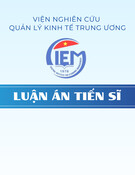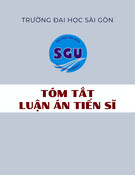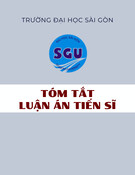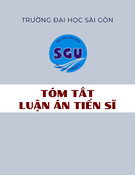
MINISTRY OF EDUCATION AND TRAINING
MINISTRY OF INDUSTRY AND TRADE
VIET NAM INSTITUTE OF INDUSTRIAL AND TRADE POLICY AND STRATEGY
LE THI THU HUONG
DEVELOPMENT OF OVERSEAS VIETNAMESE
GOODS DISTRIBUTION SYSTEM
Major: Commercial
Code: 9.34.01.21
SUMMARY OF THE DOCTORAL THESIS
HANOI, 2022

The work is completed at:
Viet Nam Institute Of Industrial And Trade Policy And Strategy
Science instructor: 1. Assoc.Prof.Dr. Dinh Van Thanh
2. Assoc.Prof.Dr. Ngo Thi Tuyet Mai
Reviewer 1:
Reviewer 2:
Reviewer 3:
The thesis is defended before the Institute's thesis grading committee,
meeting at Viet Nam Institute Of Industrial And Trade Policy And Strategy
at … hour … on day … month … year 20…
Thesis can be found at:
- National Library of Vietnam;
- Library of Viet Nam Institute Of Industrial And Trade Policy And Strategy

1
PREAMBLE
1. Necessity of the thesis topic
The development of the distribution service industry is closely related to the level of
development, economic structure characteristics and policies of each country. In our
country, along with the process of international economic integration in general and the
opening of the distribution service market in particular, the distribution service industry has
had a rapid development in the direction of modernity with the participation of many
domestic and foreign economic sectors.
Besides developing distribution systems (DS) of goods in the domestic market,
Vietnamese enterprises have actively developed the overseas Vietnamese goods distribution
system with many different methods such as foreign direct investment into the goods
distribution system; opening branches, representative offices and distribution stores of
Vietnamese goods in foreign countries; bringing Vietnamese goods directly into the
distribution chain of modern overseas distribution corporations... Recognizing the important
role of developing the overseas Vietnamese goods distribution system, the Prime Minister
also issued Decision No. 1513/QD-TTg dated September 3, 2015 approving the Scheme to
promote Vietnamese enterprises to directly participate in foreign distribution networks in
the period by 2020.
Over the past years, Vietnam has obtained many positive results in the development
of the domestic goods distribution system, but the development of the overseas distribution
system of Vietnamese goods is still slow and the efficiency is not high. The problem is how
to make Vietnamese enterprises actively and proactively exploit investment opportunities to
develop distribution systems to other countries. While the socio-economic context in the
country and the world is still suffering from many negative impacts from the Covid-19
epidemic, Vietnamese export turnover through the overseas distribution system is still
modest. The situation of foreign direct investment in the distribution sector is still small and
tends to decrease.
From the limitations and inadequacies in the past time and the development trend of
the overseas Vietnamese goods distribution system in the coming time, to quickly and
sustainably develop the overseas Vietnamese goods distribution system, it is necessary to
systematically research and find development solutions with scientific and practical bases. It
is found out that it is necessary to research to have practical and feasible proposals and
solutions to effectively develop the overseas Vietnamese goods distribution system in the
coming period, the PhD student has chosen the topic Development of Overseas Vietnamese
Goods Distribution System as the study topic of the thesis.
2. Study objectives and tasks
The general purpose of the study is to contribute to supplementing the reasoning,
analyzing the current situation and proposing solutions to develop the overseas Vietnamese
goods distribution system.
Based on the above purpose, the proposed study tasks are:
Firstly: Systematize and further clarify the theoretical issues of a country's goods
distribution system in foreign markets, study international experiences on this issue and
offer useful lessons for Vietnam.

2
Secondly: Assess the current situation of developing V overseas Vietnamese goods
distribution system. Draw the points of success, limitations and shortcomings and causes of
limitations to serve as a basis for solutions and recommendations in the coming time.
Thirdly: Propose the viewpoints, solutions and recommendations for the
development of overseas Vietnamese goods distribution system by 2025, with vision
towards 2030.
3. Object and scope of study
Object: The thesis studies on the reasoning, practice and solutions to develop the
overseas Vietnamese goods distribution system.
Scope:
- In terms of content, the thesis delves into the content, development form,
influencing factors and solutions to develop the distribution system of overseas Vietnamese
goods (consumer) distribution system.
- In terms of space: The Thesis studies on development of Vietnam's goods
distribution system in another country (Focus on Southeast Asia market and some countries
in Europe and America).
- Scope of time: Analyze the current situation from 2016 to 2020 and make policy
recommendations for the period by 2025, with vision towards 2030.
- Research subject: Mainly from the business perspective and further research from the
State perspective, the Association as a support and facilitating businesses to develop their
consumer goods distribution systems in another country.
4. Study Methodology
- Methodology: In order to achieve the study objective of the thesis, the author uses a
common and popular scientific study method to collect, analyze data and explain issues of
developing the overseas Vietnamese goods distribution system.
- Specific study methods: dialectical materialism method, secondary data collection
method, data analysis method, expert interview survey method...
5. New contributions of the Thesis
- In terms of reasoning: On the basis of systematizing in-depth and comprehensive issues
on the development of overseas Vietnamese goods distribution system with aspects of policy
and administration of the development of the distribution system, the thesis clarifies the unique
characteristics of the overseas goods distribution system of a country, setting up a new concept
and connotation of the development of overseas goods distribution system of a country. In
particular, clarify the content, evaluation criteria and give 5 groups of factors affecting the
development of overseas goods distribution system of a country. These are new theoretical
contributions to the development of the overseas distribution system of a country in the context of
deeper international economic integration and meet the requirements of rapid development
combined with sustainable development.
- In terms of practice: On the basis of scientific analysis and assessment of the current
situation of developing overseas Vietnamese goods distribution system in recent years, the
thesis points out the achievements, limitations and causes attributable to the State, the enterprise;
Combining theoretical and practical bases, combined with analysis and forecasting of future
contexts, the thesis establishes a number of viewpoints and development orientations, proposes 2

3
groups of solutions (for the State and for enterprises) and some specific recommendations to
develop overseas Vietnamese goods distribution system in the period by 2025, with a vision
towards 2030. Solutions and recommendations have scientific and practical bases, have many
new points on linkages to develop overseas Vietnamese goods distribution system.
Therefore, the thesis has high practical value for the development of overseas
Vietnamese goods distribution system both in terms of policy making and in enterprise aspects.
And also, it is a valuable reference for researchers and interested people.
6. Structure of Thesis
In addition to the preamble, conclusion and appendices, the thesis will have a structure of
4 chapters as follows:
Chapter 1. Overview of foreign and domestic study works published related to the thesis
topic
Chapter 2. Theoretical basis and practical experience on developing the overseas goods
distribution system of a country
Chapter 3. Current situation of developing the overseas Vietnamese goods distribution
system in the period of 2016-2020
Chapter 4. Solutions for development of overseas Vietnamese goods distribution
system by 2025, with a vision towards 2030
CHAPTER 1. OVERVIEW OF FOREIGN AND DOMESTIC STUDY WORKS
PUBLISHED RELATED TO THE DEVELOPMENT OF OVERSEAS VIETNAMESE
GOODS DISTRIBUTION SYSTEM
1.1. Overview of study works
1.1.1. Studies on the development of general goods distribution systems
In the past period, in the world and in the domestic space, study on the development of
general goods distribution system has been quite a lot, typically some of the studies listed below.
These studies are very useful references to create a theoretical and practical bases for the PhD
thesis topic.
- Vietnam Institute of Trade Research (2004), "Development of the goods distribution
system in Vietnam in the context of international economic integration", Political Theory
Publishing House [62]; Vietnam Institute of Trade Research (2006), Ministry-level scientific
project "Assessment of the current situation and orientation of the organization of distribution
channels for a number of key products of our country" [63]; Ministry of Trade and GTZ co-
chaired (2005), Project “Research on building legal framework for distribution system” [12];
Ministry of Planning and Investment (2008), Research Project "Overall development strategy of
Vietnam's service sector by 2020" [7]; Nguyen Thanh Binh (2012), PhD thesis "Improving the
policy of developing retail distribution services in Vietnam in the integration period" [13]; Pham
Huy Giang (2011), doctoral thesis "Development of a modern distribution system in the form of a
chain of retail supermarkets in Hanoi city". [27]; Le Ngoc Trung (2018), PhD thesis "Solutions to
develop the distribution system of agricultural products in the Southeast region today". [56];
Assoc.Prof.Dr. Dinh Van Thanh (2012), Ministry-level project "Participating in global value
chains through transnational companies (TNC)- Lessons for Vietnam". [53]; Vietnam Retailers
Association (2012), Post-survey summary Korea's experience: Opening the distribution-retail


























